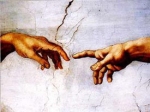Verse: John 1:29 The next day he saw Jesus coming toward him, and said, "Behold, the Lamb of God, who
takes away the sin of the world! ESV
1 Corinthians 5:7 Cleanse out the old leaven that you may be a new lump, as you really are unleavened.
For Christ, our Passover Lamb, has been sacrificed.
Read: pp. 34-52 Messiah in the Feasts of Israel by Sam Nadler.
A word about the lamb(s):
The need for a lamb offered by the Lord started with the substitute ram given to Abraham in place of his
promised son, Isaac. Isaac carried all of the substance for the future promises given to Abraham.
Without Isaac, there could be no nation to be blessed, or to become a blessing.
At the exodus, thousands of lambs were chosen and brought into the home where they became “the
lamb”. For over a thousand years Israel offered the morning and evening sacrifice which included a lamb
in the offering. That is, every day, twice a day without fail, the nation of Israel was pointing to the Lamb
that was to come and provide the true deliverance from sin (John 1:29). This does not include several
other offerings that also included lambs.
Every lamb was carefully inspected and found to be without blemish. The Tabernacle was also called the
“tent of meeting” where the priests went to meet with YHWH and communicate with Him and intercede
for the people. The offering of the lamb always preceded the burning of the incense which was the
“prayer” part of the service. The life of the Lamb was required before any communication and
fellowship with God could begin. The Sabbath points to the conclusion of our relationship with YHWH,
the Lamb is the Doorway, the required access to get there. There is no other way.
From: http://www.gotquestions.org/Passover-Lamb.html
The Passover lamb was the animal God directed the Israelites to use as a sacrifice in Egypt on the night
God struck down the firstborn sons of every household (Exodus 12:29). This was the final plague God
issued against Pharaoh, and it led to Pharaoh releasing the Israelites from slavery (Exodus 11:1). After
that fateful night, God instructed the Israelites to observe the Passover feast as a lasting memorial
(Exodus 12:14).
God instructed every household of the Israelite people to select a year-old male lamb without defect
(Exodus 12:5; cf. Leviticus 22:20-21). The head of the household was to slaughter the lamb at twilight,
taking care that none of its bones were broken, and apply some of its blood to the tops and sides of the
doorframe of the house. The lamb was to be roasted and eaten (Exodus 12:7-8). God also gave specific
instructions as to how the Israelites were to eat the lamb, “with your cloak tucked into your belt, your
sandals on your feet and your staff in your hand (Exodus 12:11; cf. Ephesians 6:14). In other words, they
had to be ready to travel.
God said that when He saw the lamb’s blood on the doorframe of a house, He would “pass over” that
home and not permit “the destroyer” (Exodus 12:23) to enter. Any home without the blood of the lamb
would have their firstborn son struck down that night (Exodus 12: 12-13).
The New Testament establishes a relationship between this prototypical Passover lamb and the
consummate Passover Lamb, Jesus Christ (1 Corinthians 5:7). The prophet John the Baptist recognized
Jesus as “the Lamb of God” (John 1:29), and the apostle Peter links the lamb without defect (Exodus
12:5) with Christ, whom he calls a “lamb without blemish or defect” (1 Peter 1:19). Jesus is qualified to
be called One “without blemish” because His life was completely free from sin (Hebrews 4:15). In
Revelation, John the apostle sees Jesus as “a Lamb, looking as if it had been slain” (Revelation 5:6). Jesus
was crucified during the time that the Passover was observed (Mark 14:12).
The Bible says that believers have symbolically applied the sacrificial blood of Christ to their hearts and
thus have escaped eternal death (Hebrews 9:12, 14). Just as the Passover lamb’s applied blood caused
the “destroyer” to pass over each household, Christ’s applied blood causes God’s judgment to pass over
sinners and gives life to believers (Romans 6:23).
As the first Passover marked the Hebrews’ release from Egyptian slavery, so the death of Christ marks
our release from the slavery of sin (Romans 8:2). As the first Passover was to be held in remembrance as
an annual feast, so Christians are to memorialize the Lord’s death in communion until He returns (1
Corinthians 11:26).
The Old Testament Passover lamb, although a reality in that time, was a mere foreshadowing of the
better and final Passover Lamb, Jesus Christ. Through His sinless life and sacrificial death, Jesus became
the only One capable of giving people a way to escape death and a sure hope of eternal life (1 Peter
1:20-21).





Terms & Conditions
Subscribe
Report
My comments